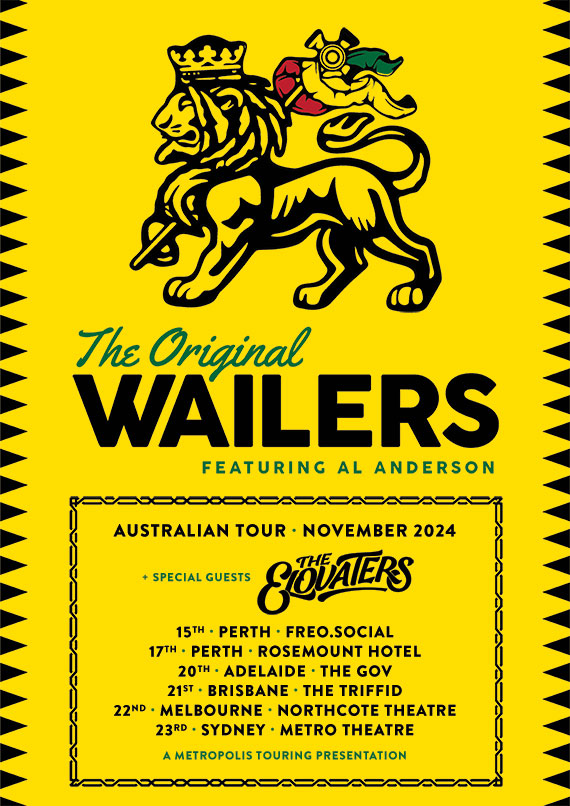
The Original Wailers (Jamaica)
+ Guests The Elovaters (USA)
Event Info
Reggae Royalty, Jamaica’s THE ORIGINAL WAILERS with their trademark sound and feel, bring the much loved hits of BOB MARLEY & THE WAILERS to life like no one else can. They will make you feel the love and happiness that only comes from true reggae music.
“One love, one heart, Let’s get together and feel alright” Bob Marley
The BOB MARLEY & THE WAILERS Greatest Hits Setlist will include – Could You Be Loved, Three Little Birds, One Love, No Woman No Cry, Buffalo Soldier, Jamming, Get Up Stand Up, Is This Love, Redemption Song + More
Featuring Al Anderson, THE ORIGINAL WAILERS have a deep connection to the soul of the message they convey. One of the few people to spend the last remaining days with Bob Marley, Al Anderson remains true to the legacy of Bob Marley. Anderson – In the last 5 days of his life he said, ‘Al, I’m going on my journey. Please honour the music that we made together and make sure the band stays together’
Don’t miss your chance to see the Legendary reggae band that started it all as they perform BOB MARLEY & THE WAILERS Greatest Hits carrying his message of love and unity. “Close your eyes and feel the power of the vibe in the room”
“For dedicated fans of reggae music, one can’t go wrong”
“It was impossible not to sing along to every song”
“some sizzling solos, some jamming, and lots of all-around high-energy fun”
“You can’t fault the mastery of performance as that sound just washes over and through your very being”
“Every single track was a joy… there can’t be a soul in the audience who doesn’t feel as though they haven’t earned their goosebumps a few times over, having connected within the words of the immortal Bob Marley himself – ‘One love, one heart, one destiny'” (Ambient Light Blog)
Bob Marley / Al Anderson Bio
In the annals of music history, few names evoke as much reverence and adulation as Bob Marley & The Wailers. Their music transcended genres, borders, and generations, becoming an anthem for the oppressed, a beacon of hope, and a symbol of unity. Though often used interchangeably, the names Bob Marley, the Wailers, and Bob Marley & the Wailers encapsulate distinct phases of a musical journey carried out by different groups of musicians. Originating as a youthful ska ensemble in the early ’60s, they evolved into a more roots-oriented collective, birthing ’70s classics like Catch a Fire and Burnin’. The departure of Peter Tosh and Bunny Wailer in the mid-’70s heralded yet another chapter, as did the tragic loss of bandleader Bob Marley in 1981. Despite these pivotal moments, the Wailers’ spirit endured, spawning various offshoots led by surviving members, ensuring their musical flame continues to ignite the hearts of new generations.
The story of Bob Marley & The Wailers begins in the vibrant neighbourhoods of Trench Town and Nine Mile, where Bob Marley, born Robert Nesta Marley, spent his formative years. Raised by his mother and influenced by the rhythms of ska and rocksteady echoing through the streets, Marley’s passion for music started at an early age. In the late 1950s, Marley crossed paths with Neville Livingston, later known as Bunny Wailer, and Winston McIntosh, known as Peter Tosh. United by their love for music and a desire for change, the trio formed a group called Teenagers, which went through several iterations before they settled on the name, The Wailers.
In 1963, The Wailers made waves on the Jamaican charts with “Simmer Down,” a track recorded at Studio One featuring The Skatalites’ rhythm section. This instant hit marked a pivotal shift in Jamaican music, moving away from mimicry of foreign styles towards an authentic portrayal of Jamaican life and culture. By the close of 1963, The Wailers welcomed vocalists Junior Braithwaite, Beverley Kelso, and Cherry Smith into their ranks. This expanded lineup featured Braithwaite on vocals, Marley on guitar, Tosh on keyboard, Wailer on percussion, and Smith and/or Kelso providing backing vocals.
Kelso departed from the group in 1965, prompting Marley, Tosh, Wailer, and Braithwaite to rotate on lead vocals. However, after Braithwaite’s stint as lead vocalist on the single “It Hurts to be Alone,” he also parted ways with the band, leaving Wailer, Marley, and Tosh as the remaining trio. That same year saw the release of their inaugural full-length album, The Wailing Wailers.
In 1966, they founded the rocksteady label Wail N Soul M. Throughout 1970 and 1971, they also worked with Lee ‘Scratch’ Perry, producing their second and third albums, Soul Rebels (1970) and Soul Revolution Part II (1971). This period also saw the recruitment of Aston “Family Man” Barrett on bass and his brother Carlton Barrett on drums, both members of the Upsetters, as instrumental backing for The Wailers. The band collaborated with esteemed reggae producer Leslie Kong, resulting in the creation of The Best of the Wailers, released in 1971.
In 1972, during their time in London, The Wailers enlisted their road manager Brent Clarke to arrange a meeting with Chris Blackwell, who had previously licensed some of their releases for his Island Records. Seeking owed royalties from these releases, The Wailers approached Blackwell, who was struck by their charisma and resilience, despite their financial struggles. Without having witnessed the band perform live, Blackwell decided to take a chance on them, advancing £4,000 to fund an album recording without any formal agreement, believing they deserved a break. Recognizing in Marley the potential to appeal to rock audiences, Blackwell saw an opportunity to break Jamaican music into mainstream consciousness. The band returned to Jamaica to record at Kingston’s Harry J’s studio, marking the first instance of a reggae band having access to a top-tier recording facility, treated with the same care as their rock counterparts.
The tracks for what would become the album Catch a Fire were primarily recorded on an eight-track system. These tracks were later taken to Island Studios in London for further production by Blackwell, under Marley’s supervision. Blackwell aimed to tailor the tracks for UK and US rock audiences. He reworked Marley’s mixes and arrangements and brought in Wayne Perkins on guitar and John “Rabbit” Bundrick on keyboard for overdubs. The album was released in April 1973, closely followed by Burnin’ in October 1973. Burnin’ included the song “I Shot the Sheriff”, later covered by Eric Claption. Clapton’s cover became his first US hit in two years reaching number 1 on the Billboard Hot 100 on 14 September 1974.
Emboldened by their success, The Wailers embarked on a world tour, spreading their message of peace, love, and unity to audiences far and wide. This tour saw the Wailers scheduled to open for Sly and the Family Stone on a 17 date tour of the United States. After four shows, the band was fired because they were more popular than the headliners.
Internal tensions and external pressures on the Wailers threatened to derail their momentum, leading to the departure of Peter Tosh and Bunny Wailer. In 1974, Livingston parted ways with the band amidst a series of disputes with Blackwell. These disagreements stemmed from issues, including non-payment for their performances during the English leg of their Burnin’ tour and Livingston’s objection to playing in venues labeled as “freak clubs,” which Island Records had arranged. Tosh held the view that producer Blackwell, whom he disdainfully referred to as “Chris Whiteworst,” was the catalyst for the deteriorating relationship among band members. He believed that Blackwell showed favoritism towards Marley, providing him with more attention and financial rewards. Additionally, tensions arose over the decision to release albums under the name “Bob Marley and the Wailers” rather than “The Wailers”.
Undeterred, Bob Marley forged ahead with a fresh new line-up, featuring Aston Barrett on bass, Carlton Barrett on drums, Junior Marvin and Al Anderson on lead guitars, Tyrone Downie and Earl “Wya” Lindo on keyboards, and Alvin “Seeco” Patterson on percussion. Adding to the ensemble, the I-Threes contributed female backing vocals, comprised of Marley’s wife Rita Marley, along with Judy Mowatt and Marcia Griffiths.
Al Anderson remains the sole member of this line up who continues to perform live. Anderson grew up in Montclair, New Jersey. He honed his skills on the trombone during his formative years at Montclair High School. His musical curiosity led him to expand his repertoire to include guitar and bass guitar. Seeking to refine his craft, Anderson pursued studies at the prestigious Berklee College of Music, sharing the halls with luminaries like Pat Metheny and Al Di Meola. Prior to his academic pursuits, Anderson immersed himself in the vibrant music scene of Boston, where he collaborated with an early incarnation of Aerosmith. His talents caught the attention of Chris Wood of Traffic, opening doors to a potential collaboration on the band’s upcoming album, although this project ultimately did not come to fruition. Nonetheless, this connection led Anderson to a position at Traffic’s record label, Island Records, where he was enlisted to contribute his skills as a lead guitarist for Bob Marley & The Wailers.
The first album from the new line up of Bob Marley & The Wailers was Natty Dread. The album contained the iconic track “No Woman, No Cry”. Natty Dread was a hit in the UK where it reached 43 on the charts and initially sold over 100,000 copies. in 2012 Rolling Stone magazine ranked the album as 181 on a list of 500 of the Greatest Albums of All time. It had held the same position on an earlier iteration of the list in 2003. The album was also included in the book 1001 Albums You Must Hear Before You Die.
The true breakout moment for this ensemble of the Wailers came with their electrifying performance at the Lyceum in London on July 18, 1975. This landmark show was captured and swiftly released on LP as Live! The live rendition of “No Woman, No Cry” soared to the U.K. charts in September 1975, achieving Top 40 status. This success saw both Natty Dread and Live! climbing the British charts, propelling Marley and his reggae sound into the global spotlight. In the United States, Natty Dread made its mark in May, followed by Burnin’ and Catch a Fire in the autumn. (The release of Live! in the U.S. was delayed for a year, but upon its arrival, it swiftly ascended to the Top 100.) While Eric Clapton’s rendition of Marley’s “I Shot the Sheriff” in 1974 had significantly boosted reggae’s popularity (the original version even graced the U.S. R&B charts that autumn), it was Marley’s own prowess as a performer that had now firmly secured his status as a star in the United States.
Bob Marley & the Wailers achieved their greatest commercial success in the United States with the release of their studio album Rastaman Vibration in April 1976. One of its standout tracks, “Roots, Rock, Reggae,” not only made a notable entry on the pop charts but also became a Top 40 hit on the R&B charts, further solidifying the band’s impact on mainstream music culture. Rastaman Vibration not only showcased Marley’s lyrical and musical prowess but also served as a powerful statement of Rastafarian ideology, resonating deeply with audiences worldwide and cementing Marley’s status as a cultural icon beyond his musical talents. Around this time, Al Anderson left the Wailers, transitioning to new endeavours, Anderson lent his musical prowess to Word, Sound and Power – Peter Tosh’s new band , supporting Tosh on acclaimed albums such as Legalize It and Equal Rights.
On December 3, 1976, Bob Marley, Rita, and manager Don Taylor were subjected to an attack by unidentified gunman in the Marley home. This was just two days before Marley was scheduled to perform at a free event organized by Jamaican Prime Minister Michael Manley aimed at bridging tensions between opposing political factions. Taylor and Rita sustained severe injuries but eventually recovered fully. Bob Marley himself suffered minor wounds to his chest and arm. Despite the harrowing incident, the concert proceeded as planned, and Marley, despite his injuries, bravely took to the stage two days later. The band Zap Pow provided backup for Marley before a massive crowd of 80,000 festival-goers. Following the assault, Marley relocated to England for some time.
While in England Marley recorded hit albums, Exodus and Kaya. The albums were slightly more uptempo and influenced by disco. Exodus included four UK hit singles “Waiting In Vain”, “Jamming”, “One Love” and the title track. Exodus was Marley & The Wailers first top 10 album in the U.K. Exodus stayed on the British album charts for 56 consecutive weeks! In the U.S., Marley faced some pushback from genre conscious radio programmers who weren’t sure where his music fit as reggae didn’t easily fit in with rock or R&B radio stations and audiences. “Exodus” and “Waiting in Vain” made the R&B Top 20 and Top 40 respectively, but neither reached the Pop charts in the U.S. Kaya was an even greater success than Exodus in the UK. Kaya reached the top 5 of the albums chart in the U.K driven by the advance single release of “Is this Love”, which was a Top Ten hit on its own. In the U.S. Kaya struggled as it didn’t fit into America’s conventions of popular music.
Returning to the fold of Marley’s band, Al Anderson returned for the classic live album, Babylon By Bus. He would go on to contribute to the studio albums Survival and Uprising. Survival reached the Top 20 in the U.K. Uprising was released in 1980 and featured the single, “Could You Be Loved” – the single and album reached the top 10 in the U.K. charts. Uprising was scheduled to be promoted with a U.S. tour but Marley fell ill soon after the album’s release and was forced to cancel the majority of his tour dates.
Bob Marley’s untimely death from Cancer in 1981 sent shockwaves through the world, but his music and message endured. In the decades that followed, Bob Marley & The Wailers’ influence only grew stronger, inspiring countless artists and activists to carry on their legacy. The hits collection, Legend: The Best of Bob Marley & The Wailers, was released in May 1984 and was a huge sales success. By the year 2000 the album was certified for sales of over ten million copies worldwide.
After Marley’s untimely passing, Anderson’s commitment to music remained unwavering. He continued to tour with The Wailers Band, expanding his collaborative horizons with esteemed artists such as Ben Harper, contributing to the critically acclaimed Diamonds On the Inside (2003). Anderson’s versatility shone brightly on Lauryn Hill’s groundbreaking debut album, The Miseducation of Lauryn Hill (1998), which earned multiple Grammy Awards.
Further showcasing his multifaceted talents, Anderson ventured into production, notably collaborating with actor Steven Seagal on the album Songs from the Crystal Cave (2005). In 2008, he embarked on a new chapter, co-founding the band The Original Wailers alongside Junior Marvin, continuing to captivate audiences with his musical brilliance. In 2012 The Original Wailers released an EP, Miracle, which was nominated for Best Reggae Album at the Grammy Awards.
From the streets of Kingston to stadiums around the globe, the music of Bob Marley & The Wailers continues to transcend boundaries and unite people of all backgrounds. Through their music, they gave voice to the voiceless, hope to the oppressed, and inspiration to generations. Their songs of love, peace, and revolution serve as a reminder of the power of music to effect change and uplift humanity. As long as their songs are sung and their message is heard, the spirit of Bob Marley & The Wailers will live on, forever immortalized in the hearts and minds of music lovers everywhere.



